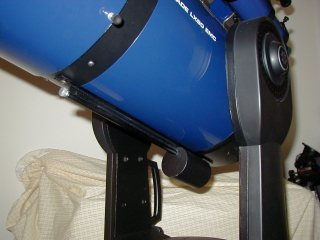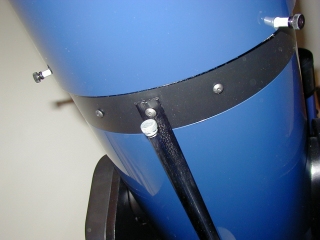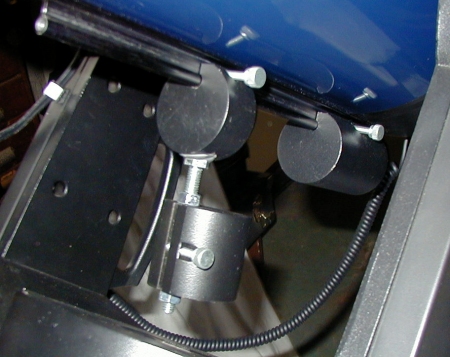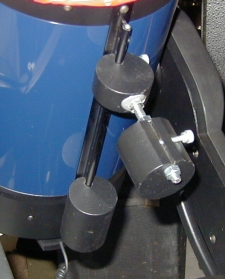

The 3 pound weight on the rail in alt/az, and all three weights - 3, 2 and 1 pound
The Meade Weight Set and Weight Mod
After attaching the Meade dew shield, I noticed the scope was front end heavy without the Nikon and the OAG attached to the rear port. The additional camera equipment balanced out the OTA with the dew shield attached. Since I had a Skywatcher short tube refractor on order, I decided to purchase the Meade weight system as well. My concern was that with all the additional weight, the OTA would need to be balanced when changing equipment around.


The 3 pound weight on the rail in alt/az,
and all three weights - 3, 2 and 1 pound
The Meade weight set comes with no directions. You get the rail, two washers, two thumbscrews, and three weights of 1, 2 and 3 pounds with thumbscrews. To install the unit, remove two screws from the bottom of the OTA, one in front and one at the rear. They must be axially aligned - the slider will not match unless they are. Attach the slider rail to the OTA using the two washers between the OTA and the slider rail. The two extra thumbscrews attach to the rear and front of the slider to keep the weights from falling off the slider (if their thumbscrews loosen).

Mounting screw, rail and safety thumbscrew
Once you have the slider rail installed, the weights slide on to the rail and the thumbscrews are tightened when the weights are in the proper position. Be sure you replace the thumbscrew on the end of the slider rail.
The Meade weight set is an axial weight set, it does not allow you to move the weights away from the OTA, nor does it allow you to set the weights off center unless you move the rail. I intend to change this in the near future by drilling and tapping a 5/16-18 hole in the 1 pound weight. This will allow me to attach a threaded rod vertically away from the weight. Additional weights could be attached using the rod or bolt in the same manner as they attach to the slider.
Updated 3/18/02 I've added some new images of the modified weight set (better late than never). One hole was drilled and tapped for a 5/16-18 all-thread rod, which was then screwed into the hole. I added a nut and some JB Weld (epoxy) for safety's sake. I didn't want the rod coming off and the weight to fall on the battery compartment. Two additional nuts secure and adjust the vertical weight's distance. This arrangement allows me to use all three weights (1, 2 and 3 = 6 lbs) to counter balance the Losmandy rail, ST80 and any accessories properly. One word of advice - these weights are extremely hard, so use lots of light oil to lubricate the weight and tools when drilling and tapping it. Make sure your threaded rod is short enough to clear the battery compartment while slewing in declination. Meade should include a tapped hole in their weights for this purpose, it would certainly benefit the functionality of the weightset as a whole - a simple solution to transform the weightset into a 2D system.


The one pound weight drilled and tapped for
a 5/16-18 all-thread, with the 2 pound weight installed. Note the
epoxy.
Balancing the OTA
Proper balance is a must if you wish to avoid replacing the RA and/or Dec bearings. To balance an OTA the weights must be positioned in such a way as to offset the added weight from accessories or piggybacked scopes. The balance weight should be placed directly opposite the accessories, and should be the same distance away from the OTA. This is not possible with the stock Meade weight set, but you can get pretty close by using different weights at different positions on the slider. If you just have large EP's or camera equipment on the visual back, you should have no problem balancing the OTA with small weights to the front. The Meade dew sheild works quite well all by itself to balance out accessories on the visual back.
If you have a guider scope, large finder, or heavy camera piggybacked, make sure your weights balance the OTA vertically and horizontally both. It may be necessary to modify your weight set to provide a 2d balance system, similar to the Losmandy weight set.
A telescope should be balanced vertically first, to get the center of gravity in line with the center axis of the optical tube. Weights should be added, moved away from, or towards the OTA to achieve balance in the vertical position. Once the scope is balanced vertically, it can be moved to horizontal and the weights can be slid front or rear along the rail as required to balance the tube horizontally. More detailed information here.
| Back to Contents || Wedge adapter || Focuser || Azimuth adjuster || Weight Set || Dovetail ||
|| Compass || Polar || Pinouts || Tours/Ephemerides || Balancing ||